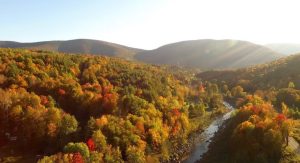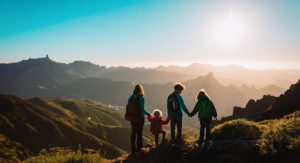Introduction — A Friendly Invitation
Have you ever Discover the Catskill Mountains in New York what it feels like to stand among ancient peaks, breathe crisp forest air, and hear rushing waterfalls just a few hours from the city? Maybe you’ve been daydreaming about a real break—where you can hike, relax, and explore charming towns without feeling overwhelmed by tourist traps. That’s exactly where the Catskill Mountains in New York come in.
In this article, I’ll guide you through everything you need to know—from what “Catskills” really means, to how to plan your perfect getaway, what to expect on the trail, where to eat, and even what not to do. By the time you’re done reading, you’ll feel like you’ve walked those trails yourself, and you’ll be ready to plan a trip that’s both unforgettable and uniquely yours.
What Are the Catskill Mountains?

Definition and Geography
The Catskill Mountains—often just called the Catskills—are a forested, mountainous region in southeastern New York State, part of the larger Appalachian chain. Covering roughly 6,000 square miles, they include peaks like Slide Mountain (the highest at 4,180 feet) and hundreds of miles of scenic ridgelines, valleys, and waterways.
A Brief Origin Story
Once part of the ancient Acadian mountain range, the Catskills are older than the Rockies, worn by time and shaped by glaciers and rivers. In the 19th century, artists in the Hudson River School romanticized their landscapes. Today, that legacy lives on in the vibrant forests, dramatic cliffs, and peaceful streams.
Why Visit the Catskill Mountains?
Benefits You’ll Actually Use
- Easy Access: Just two to three hours from New York City, Albany, and even parts of New Jersey. You get a wilderness feel without a cross-country flight.
- Varied Experiences: From leisure hikes and fall foliage drives to rugged climbs and waterfall chases—there’s something for every level.
- Rich Culture: Rustic lodges, artisan farms, local breweries, galleries, and historic inns bring personality beyond the outdoors.
- Seasonal Magic:
- Fall: A painter’s palette of reds, golds, and oranges.
- Winter: Quiet, snow-blanketed solitude (and skiing options).
- Spring: Wildflower-framed streams.
- Summer: Cool, shady trails and swimming holes.
Common Misconceptions & Challenges
Myth: “The Catskills Are Just for Hikers”
Sure, there are amazing hikes—but even non-hikers will enjoy scenic drives like the Devil’s Path byway, historic towns like Woodstock, or canoeing on Esopus Creek.
Myth: “It’s Only Good in the Fall”
The Catskills have strong appeal year-round. Summer brings swimming and lush greenery, winter brings cross-country skiing and fire-lit inns, spring is wildflower-rich and less crowded.
Challenge: Parking and Trailhead Crowds
Some favorite spots (Kaaterskill Falls, Hunter Mountain) get packed, especially on weekends and holidays. Plan to arrive early or explore lesser-known gems—keeping a wide-angle of options is key to avoiding congestion.
Step-by-Step: Planning Your Catskills Trip
1. Set Your Focus and Timeline
Ask yourself:
- Are you craving adventure (climbing Slide Mountain, exploring North-South Lake)?
- Looking for relaxation (a weekend in Phoenicia or Tannersville)?
- Wanting a mix—day hikes, good meals, and gallery browsing?
Then choose:
- Weekend (2-3 days): Base yourself centrally (e.g., Hunter or Kingston), hit a trail, grab local eats, unwind.
- Week-long getaway: Split your stay—start near one town, move deeper for different views and vibes.
2. Choose Your Base Location
- Phoenicia: Charming, central. Great for tubing or the Esopus Creek.
- Hunter/Tannersville: Lively, with mountain eateries, shops, and ski-lifts in winter.
- Kingston: Historic, riverside, more urban—but still close to hikes.
- Halcottsville/Livingston Manor: Quiet, less touristy, perfect for peace and nature immersion.
3. Assemble Your Activities Mix
| Interest Type | Example Activity | Why It Works |
|---|---|---|
| Water and Relaxing | Swim at Kaaterskill Falls, tube Esopus Creek | Refreshing and photogenic |
| Hiking | Climb Slide Mountain or hike North-South Lake loop | Varied difficulty, scenic rewards |
| Fall Foliage Drives | Wind through Catskill Forest Preserve roadways | Colors, overlooks, impromptu picnic stops |
| Culture/Food | Shop galleries in Woodstock, try farm-to-table eateries | Local art, magic of small-town NY, hearty and creative food |
| Winter Sports | Ski Hunter, snowshoe or x-country around Phoenicia | Fewer crowds, half-mile beyond, winter wonderland |
4. Pack Smart (Seasonal Essentials)
- Spring/Fall: Layered clothing, waterproof boots, mosquito repellent.
- Summer: Sunhat, hiking sandals, light shirt, bug spray.
- Winter: Insulated layers, micro-spikes or snowshoes, hot thermos, flashlight.
Pro Tip: The weather in the Catskills can shift quickly—those rocky ridgelines get windier and cooler fast.
5. Reserve Smartly
- Book lodging early for peak seasons (fall weekends, summer holidays).
- If you plan guided hikes or rafting tours, reserve ahead—especially weekends.
Real-Life Scenarios: How Different Travelers Approach It
The Weekend Adventurer
You’re based in NYC and want an escape by Friday evening. Drive up, check into a Woodstock B&B, hike the Platte Clove area, grab dinner in Tannersville, wake up to a breakfast café, and hike North-South Lake or climb Overlook Mountain before heading home—refreshed and full of nature-charged energy.
The Family with Kids

Looking for kid-friendly fun? Try low-impact hikes like Kaaterskill Falls (just mind the safety), explore interactive nature exhibits (like at the Catskill Interpretive Center), and paddle on gentle lakes. Bonus: bring a picnic and let the kids splash while you enjoy the mountain scenery.
The Culture Lover
Maybe hiking isn’t your priority. Swap it for gallery browsing in Woodstock or Saugerties, catch a folk performance or quirky local festival, explore local wineries or breweries, and sample locally sourced meals—yet still feel nestled among quiet peaks.
The Snow-Seeker
Winter powder calls? Go skiing at Hunter or Belleayre. On quieter days, snowshoe or cross-country ski along the wind-silenced trails. Cozy up by the fire in a rustic lodge or sip hot chocolate in a mountain café. The winter quiet is its own magical reward.
Common Mistakes—Avoid These!
- Skipping the Weather Check: Dressing only for warmth when it’s sunny at the car but freezing at 4,000 feet isn’t fun. Always bring layers.
- Overpacking Your Day: Trying to do 5 hikes in one day? It’ll burn you out. Plan realistically—quality beats quantity.
- Ignoring Trail Etiquette: Stay on marked trails, pack out your trash, respect wildlife. Leave it as beautiful as you found it.
- Underestimating Trails: A “moderate” hike might mean rocky, steep terrain—especially in wet or icy conditions.
- Not Bringing Water: Even a short hike needs hydration—pack snacks, water, and a map or trail app.
Tips, Comparisons, and Other Options
Hiking Trails Compared (Quick Look)
- North-South Lake Loop: Moderate, scenic, lakes and cliffs.
- Slide Mountain Trail: Strenuous ascent, epic summit views.
- Devil’s Path (even a portion): Rugged, challenging, incredibly rewarding.
- Kaaterskill Falls Trail: Short, scenic—but can be crowded near the parking lot.
Alternatives to Hiking
- Mountain Biking: Plenty of forest roads and trails around Phoenicia.
- Fishing: Coldwater streams and rivers abound—great for trout anglers.
- Photography Tours: Fall and spring are photographer magnets—plan for golden hour shots.
- Wellness Getaways: Some lodges offer yoga retreats, spa packages, quiet writing-retreat stays.
Trends & Insights
- Micro-tourism: People now prioritize local, low-impact travel. The Catskills are thriving on this.
- Agri-tourism: Farm stores, pick-your-own apples, maple sugaring in early spring, and local cheesemakers are gaining attention.
- Outdoor Education: Visitor centers and guided naturalist walks (especially in spring/fall) are growing.
- Digital Detox: More travelers are choosing lodges with little to no Wi-Fi to really unplug and recharge.
FAQs — All the Readers’ Burning Questions Answered
Q: When is the best time to visit the Catskills?
A: It depends on what you want. Fall (late September to early October) delivers the best foliage. Summer (June to August) is great for water activities. Spring (April to June) shows wildflowers and babbling brooks. Winter (December to March) brings snow-sports and peaceful quiet.
Q: Are the Catskills good for beginners?
Absolutely. Trails like North-South Lake, Kaaterskill Falls (from approved areas), and Overlook Mountain are accessible. Just take your time, bring proper gear, and check conditions.
Q: How do I avoid crowds?
Go mid-week or early morning, head to less-famous trails like those near Livingston Manor, or plan shoulder-season visits in spring or winter when the foliage or snow is the draw.
Q: Can I visit with dogs?
Yes—many trails and towns are dog-friendly. Keep your pet leashed, respect local regulations, and pick up after them. Slippery or icy trails in winter may require extra caution.
Q: What gear do I really need on a day hike?
At minimum: layered clothing, sturdy shoes, water, snacks, sun protection, and a small first-aid kit. If you plan on summiting or reaching exposed ridges, add wind/rain layers.
Q: Are there guided tours or shuttle services?
Some towns and outfitters offer guided hikes, waterfall tours, and shuttle services, especially during peak foliage season. Check local tourism offices for current offerings.
Q: What should I eat and drink in the Catskills?
Farm-to-table cafés, artisan bakeries, local breweries, and cozy taverns abound. Favorites: shakshuka at Phoenicia Diner; craft beer at Keegan Ales; fresh-baked goods in Saugerties. Try local cheese, cider, or maple syrup for a regional treat.
Closing Thoughts — Your First (Or Next) Catskills Adventure
If you’re still reading this, you’re already ahead of most would-be travelers. Planning a visit to the Catskill Mountains doesn’t have to be mysterious or stressful. You now know how to pick the right base town, match your activities to your interests, pack shrewdly, avoid crowds, and discover both well-known and hidden delights.
So here’s a simple next step: pick just one thing—maybe a moderate hike, a scenic drive, or a local café—and plan around that. Let the rest of your trip unfold naturally between forest trails, hidden waterfalls, and star-lit nights. Before you know it, you’ll be breathing that fresh Catskill air and saying, “I can’t believe I waited this long to go.”
I hope this article becomes your go-to Catskills guide—so full of insight and warmth that you won’t need to look anywhere else. Let me know if you’d like help planning a specific itinerary or exploring a niche angle like wildlife watching, photographic routes, or winter snowshoe paths.
